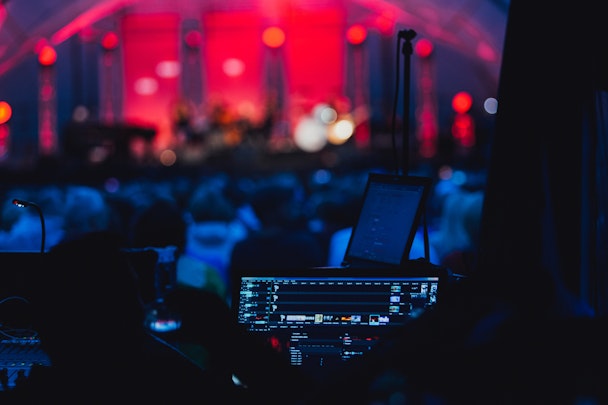I’m deaf, but it’s the event industry that can’t hear. How can it be more inclusive?
Despite the shift to virtual in recent years, in-person events are still nowhere near accessible enough. Meg Strahle of Momentum investigates how brands can do better.

Shedding light on the entertainment industry, Meg Strahle asks: how can we create more inclusive events and experiences? / Markus Spiske via Unsplash
The events industry has long overlooked minority communities, including the d/Deaf community (although, did you know that 80% of people who use captioning don’t have hearing loss?)
Think about those who don’t speak English as a first language going to an event in a loud or crowded place, or an office with a train station, construction site, or screaming kids in the background. It quickly adds up to many being excluded. So, what has been done so far, and where can improvements still be made?
I’ve spoken with many d/Deaf people who have said they don’t have a support system to ensure they are included and welcome at events. Pre-pandemic, I was often refused a sign-language interpreter or reserved seating to be closer to the stage, citing budget or ‘first-come-first-served’.
With my Cochlear implant and my ability to lip-read I can get by at events, but it requires ample lighting, carpeting, and good acoustics. What about those who don’t have the same abilities?
Advertisement
The industry's ignorance is disempowering
When the pandemic hit and events became 100% virtual, there was no captioning available for most events. I was fatigued from spending my entire day online in meetings or events with no support. People don’t understand that listening and working to be included in conversations takes considerable energy.
Nearly three years later, there are some virtual platforms that have captioning for events, but not nearly enough. Personally, I’m at a point in my life and in my events career where I’m happy to not attend events if their producers can’t make them accessible, or to leave if an event falls short of promised accessibility. Others may not feel able to do the same.
The d/Deaf community are also often able to notice more details as the loss of a sense heightens others, like taking in the visuals, smells, and tastes of an event, so these must be considered when creating them.
All anyone wants is to feel included and that’s no different for people who are d/Deaf when it comes to in-person events and experiences.
Advertisement
Setting a new standard for events
Steps have been taken by the wider experiential industry that our industry can learn from. Just look at the Ted X London Women’s event, a virtual event that occurs every year, ran by volunteers. It’s not just inclusive for the d/Deaf community, but for anyone who wants to attend. The platform used captioning which controlable by users, and the range of speakers was incredibly diverse.
Or, you might’ve heard about Coldplay’s hard pause on concerts until they could figure out how to tour sustainably. Earlier this year in May, they announced initiatives to influence inclusivity at every single concert, from offering Subpac immersive audio experince vests to ensuring at least two sign language interpreters attended every show.
Coldplay also partnered with KultureCity to provide sensory bags and a mobile sensory refuge station for attendees who have sensory issues. For attendees with visual impairments, they offer a pre-concert touch tour, too. After their announcement in May, social media blew up with praise for their work to be sustainable and inclusive.
Suggested newsletters for you
Accessibility is more attainable than you think
Contrary to what people often say, making events inclusive isn’t very expensive. So much technology already exists for free captioning on Teams, Google Meet, and Zoom (if the organizer remembers to turn it on). Similar options exist for YouTube, LinkedIn Live, Facebook, and Instagram.
It’s always worth looking at the design of every project and considering who might be excluded. If it’s dark and loud, it may be tricky for d/Deaf and blind/low vision attendees to get around as well as alienating people with sensory issues.
If you have flashing lights, particularly in concerts or shows, it’s key to let people know beforehand in case they are susceptible to seizures. I personally avoid putting in autoplay videos and gifs in websites or presentations, instead having a ‘play’ button in place – some easy and free considerations to take if budget is a concern.
It’s OK to make mistakes; it’s how we learn for next time. The most important thing is to be transparent and take your learnings into the next event. We don’t need you to be perfect, we just need you to try. Communication is important in the learning process towards creating inclusive experiences.
Content by The Drum Network member:

Momentum Worldwide
Momentum Worldwide is a global experience agency partnering with and transforming the world’s most famous brands since 1987. Built on the simple truth that it’s...
Find out more
